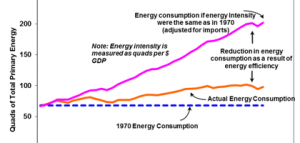 U.S. energy use is approximately half of what it would have been if we had not improved our efficiency over the past 40 years. Still, there are large, cost-effective opportunities to increase energy efficiency much further, thereby helping us to cut energy bills, reduce pollution, and encourage economic growth.
U.S. energy use is approximately half of what it would have been if we had not improved our efficiency over the past 40 years. Still, there are large, cost-effective opportunities to increase energy efficiency much further, thereby helping us to cut energy bills, reduce pollution, and encourage economic growth.
While there is disagreement among politicians about the role of government spending and government regulations to spur cost-effective energy efficiency investments, politicians of all political stripes agree that knocking down market barriers that keep Americans from saving money is a worthy task.
Within this context, the American Council for an Energy-Efficient Economy (ACEEE) released a new report on Monday highlighting 16 policies that would use market forces to spur additional cost-effective investments in energy efficiency while helping to surmount market barriers that hinder these investments. In total, these policies could save consumers and businesses nearly $1 trillion over the 2014-2030 period, considering both the energy bill savings and the cost of the energy efficiency investments.
The new ACEEE report, Overcoming Market Barriers and Using Market Forces to Advance Energy Efficiency, discusses several targeted policies that leverage market mechanisms in order to address specific market failures, without requiring substantial spending or government mandates. For example, the development of a comprehensive building labeling and benchmarking program would allow purchasers and tenants to identify efficient homes and commercial buildings and could save consumers and businesses approximately $60 billion between 2014 and 2030. Even more impressive are the benefits gained from adjusting corporate tax legislation to remove hidden barriers in the tax code. These adjustments would encourage the replacement of inefficient equipment and remove regulatory barriers to combined heat and power projects. These two policies alone could save the economy close to $300 billion.
Recommendations fall into 7 categories:
-
Improving information to aid decision making
-
Removing exiting regulator and legal barriers
-
Addressing externalities
-
Increasing the salience of energy use at point of purchase
-
Reducing energy waste in government
-
Investing in precommercial R&D
-
Enhancing energy efficiency finance
READ ABOUT 16 POLICIES THAT COULD SAVE THE U.S. ECONOMY ALMOST $1 TRILLION…
Share this post: